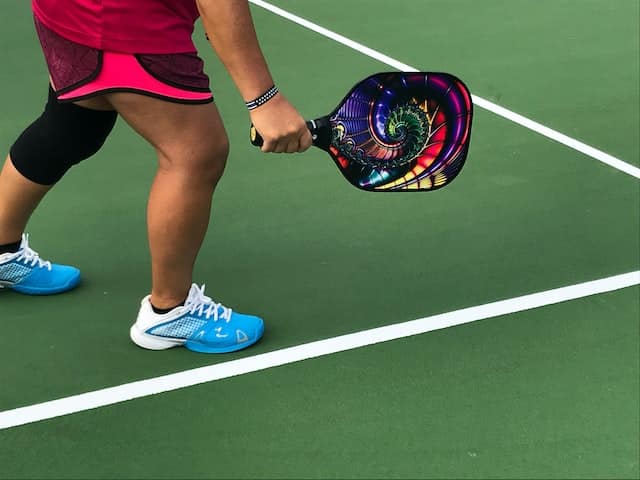The pickleball court is a relatively new addition to the sports world, but it’s quickly becoming an extremely popular option for all fitness-seekers. While pickleball has taken off in recent years, it’s still quite different from its original counterpart – the tennis court.
Tennis courts can be used to play pickleball, but pickleball courts are specifically designed with pickleball’s rules in mind. When considering Pickleball Court vs Tennis Court, it’s important to look at the dimensions of each court and see what pickleball rules require for an official pickleball game.
When comparing pickleball and tennis courts, it’s important to understand the differences in size, shape, and surface – all of which can significantly affect a player’s game.
Let’s take a closer look at pickleball vs. tennis courts and how these key components come into play.
What is Pickleball?

Pickleball is a rapidly growing sport incorporating aspects of badminton, tennis, and table tennis. It uses a light plastic perforated ball, a net, as well as carbon fiber and fiberglass paddles, and a much smaller court than the standard size for tennis. No prior experience is necessary to pick up pickleball skills, but tennis players may learn the rules quicker, given the similarities.
Pickleball court sizes are significantly smaller than those of traditional tennis courts. Because the pickleball is made with plastic and has perforations, it travels much slower than a standard tennis ball. Furthermore, pickleball can be better controlled than a regular tennis ball due to its aerodynamic shape. Therefore, pickleball is much easier for those with experience in other sports involving racquets, such as squash, badminton, racket ball, or table tennis. The familiarity of stroke production combined with pickleball’s slower speed and better control makes pickleball a great game for all levels of players.
The pickleball court is significantly smaller than a tennis court, providing a more intimate playing experience. This also allows players to reach shots more easily and move around the court with greater agility.
Furthermore, pickleball is less physically demanding than tennis, making it an ideal sport for people of all ages and levels of athleticism. Additionally, the pickleball ball is made of plastic, which provides less bounce than a tennis ball. As a result, fewer uncoerced errors are made because players have less to do to hit successful shots.
Also, shorter players benefit from pickleball because they can bend over more than playing tennis with a longer racquet.
Tennis Courts Vs. Pickleball Courts
The pickleball vs. tennis game debate is gaining traction in North America as more and more former tennis players turn to pickleball. With pickleball courts becoming increasingly crowded while prime-time tennis courts remain largely empty, pickleball facilities are popping up all over the continent. As a result, there has been an increasing number of tennis courts being converted to pickleball courts.
Dimensions
Tennis courts can be used as pickleball courts. It’s important to know the differences between tennis and pickleball courts before making a pick. When comparing pickleball with tennis, size and dimensions are two of the most critical factors for players to consider. The rules of pickleball do not require a specific court size, meaning pickleball can be played on existing tennis courts. This is ideal for pickle ballers who want to play pickleball but don’t have access to pickleball-specific courts.
The main difference between tennis and pickleball court sizes is the width. Tennis courts are typically 23 1/2 feet wide, while pickleball courts are 20 feet wide. This difference is significant since pickleball players need a bit more room to maneuver than tennis players. Pickleball is typically played on a court with dimensions that are smaller than those of traditional tennis courts. Pickleball courts are 20 x 44 feet in size, which is about ¾ of the area of a standard tennis court (78 ft. x 36 ft.). This smaller size creates a faster-paced game, as pickleball players don’t have to run as far and can play shots at a closer range.
Additionally, pickleball courts are shaped differently from tennis courts. Pickleball courts feature shorter backlines (20 feet instead of 36) and wider sidelines (44 feet instead of 23 1/2). This spacing creates a pickleball court that is more of an oval shape instead of the rectangular court used for tennis.
Furthermore, pickleball courts also require slightly different lines, and pickleball courts are typically smaller than tennis courts, meaning pickleball can be played in a much smaller space. This makes pickleball a great option for those living in urban areas or with limited space. Although the surface of pickleball courts is different from tennis courts, they can both be used to play pickleball. Pickleball courts often have cushioned and porous surfaces, which can provide more “give” than a traditional hard court. The pickleball court surface also offers more traction, making pickleball easier on the joints and offering more controlled bounces.
Tennis Rackets vs. Pickleball Paddles
Another major difference between pickleball and tennis is the equipment used. The paddles used in pickleball are much smaller than the racquets used in tennis; they typically measure 8-12 inches in length and 7-15 inches in width. The smaller paddle size allows for greater control while increasing maneuverability around the court.
This can help players hit shots with more accuracy and spin, which is necessary for the game of pickleball. Additionally, the lighter weight of pickleball paddles makes it easier for players to move quickly around the court, giving them an advantage over tennis players who may be using heavier racquets.
The shape of pickleball paddles is different than that of tennis racquets. Pickleball paddles are generally constructed from plastic, wood, or carbon fiber and feature a flat surface with rounded edges. This is designed to give players more control over the ball while playing pickleball. The shape and size of the paddle allow for increased maneuverability around the court and make it easier to create a spin on the ball.
Balls
Another major difference between tennis and pickleball is the type of ball used. Tennis balls are usually much bigger than pickleball balls, measuring 2.7 inches in diameter, compared to pickleball balls that measure 2.9-3.0 inches in diameter. The smaller size of the pickleball ball makes it easier for players to maneuver around the court and control shots with spin. Additionally, the heavier weight of tennis balls can make them more difficult to hit with accuracy and spin, while the lighter weight of pickleball balls can make it easier for players to control shots.
Finally, pickleball balls are hollow and have holes in them, while tennis balls are solid. This difference creates a different sound when the ball is hit, which adds an element of strategy to the game.
How Many Pickleball Courts Can Be Made on One Tennis Court?
It is possible to create two or even four pickleball courts on one standard-sized tennis court. This requires dividing the court into two equal parts with a net in between. Doing so will allow each player to have their court while still being able to use the same court surface and fencing. Additionally, it makes switching from pickleball to tennis or vice versa very easy and efficient.
For four pickleball courts, the court will be divided into four equal parts with three nets in between. This is more of an advanced configuration and will require more time and effort, but it can be a great way to accommodate more players at once.
Converting a tennis court to a pickleball court is an ideal solution for pickle ballers who don’t have access to a dedicated pickleball court. With the right dimensions and lines, it’s possible to create one, two, or even four playable pickleball courts on one tennis court. Regardless of which pickleball court configuration you choose, pickleball players should consider their needs and preferences to pick the best option for themselves. With various court sizes and surfaces available, pickle ballers can find the perfect court for their game.
Factors To Consider Before Converting a Tennis Court to Pickleball Court
Before anyone converts a tennis court to pickleball, there are certain factors they should consider. The most important factor to consider is the size of the existing court. If it fits within pickleball dimensions, then pickleball can be played on it with minor modifications.
Other factors to consider include lighting, net height, surface type, and markings. Converting a tennis court into pickleball isn’t always easy, but pickle ballers can make their pickleball dreams come true with the right knowledge.
All in all, pickleball and tennis courts are similar yet different due to their sizes and pickleball court surfaces.
How to Convert a Tennis Court to Pickleball Court?
Measure the pickleball on tennis court dimensions and make sure they meet pickleball court standards. Pickleball courts are 20 feet by 44 feet (6.1m x 13.4m), whereas tennis courts are typically 78 feet by 36 feet (23.7m x 10.9m). Some modifications may be needed if the existing court does not meet pickleball court dimensions.
Install a pickleball net or use an existing tennis net if it meets the required height of 36 inches (91 cm). If the existing net is too tall, purchase a shorter one and install it at the proper height for pickleball.
Mark the court with pickleball lines according to official court dimensions. The lines should be visible and non-slip, so they don’t cause injury to players.
Place boundary markers on the sides of the court to indicate where the ball has gone out of bounds. Markers should be placed at least one foot away from the court lines to ensure they don’t interfere with play.
Add lights if the court is going to be used at night or in low-light conditions. This helps players see where the ball is heading and allows for a much more enjoyable game.
Check the court surface for any debris or hazards. Pickleball courts require a smooth, even surface that is free of any obstructions. Repair the court with resurfacing materials if the court has loose stones or cracks.
Finally, ensure the court meets all safety regulations and is suitable for play. This includes ensuring there are no exposed edges on the pickleball net or court lines that could cause an injury.
With these steps, players will have a safe and enjoyable pickleball experience on their converted tennis court.
Remember to follow the official court dimensions and safety guidelines when converting a tennis court to a pickleball court for optimal performance and fun.
Pickleball Court Etiquette Guidelines
Additionally, pickleball players should follow additional pickleball court etiquette guidelines to ensure an enjoyable pickleball experience. Here are some suggestions:
- Maintain a safe distance from other pickleball players and respect the personal space of others on the court.
- Keep conversations to a low volume while playing pickleball so as not to distract fellow pickle ballers.
- Avoid using offensive language or gestures that could be considered disrespectful.
- Follow pickleball rules and regulations, including pickleball court size dimensions.
- Respect the pickleball court surfaces, net posts, and other equipment on the pickleball court.
- Avoid hitting pickles outside of your designated area or “playing to” different players without their consent.
- Allow others to join pickleball games without making them wait unnecessarily.
- Always demonstrate proper sportsmanship and pickleball court etiquette.
With these tips, pickleball players can make sure they’re playing pickleball according to the official court dimensions and safety guidelines and follow proper pickleball etiquette.
Can You Convert the Pickleball Court Back to Tennis Court?
Yes, converting a pickleball court back to a tennis court is possible. However, some steps must be taken to ensure the conversion is safe and successful.
First, remove any pickleball lines or boundary markers from the court surface.
Next, repair any damage to the surface caused by installing the net posts.
Finally, reinstall a tennis net at the proper height and mark out the official tennis court lines. Once these steps are completed, players can enjoy playing tennis on their converted courts.
Before attempting to convert the court back to a tennis court, it’s important to ensure that all pickleball lines and boundary markers are removed properly and that any damage to the surface is repaired. Failure to do so can result in an unsafe playing environment for tennis players.
Also, remember that the official rules and guidelines should be followed when converting a tennis court to a pickleball court. This ensures that the players play on a safe and suitable court for optimal performance.
Following these tips and taking the necessary steps, you can easily convert your pickleball court back to a tennis court and enjoy both sports.
Conclusion
Overall, converting a tennis court to a pickleball court is an easy process that requires following official court size dimensions and safety guidelines. Additionally, remembering proper pickleball court etiquette will make the experience enjoyable for everyone.

